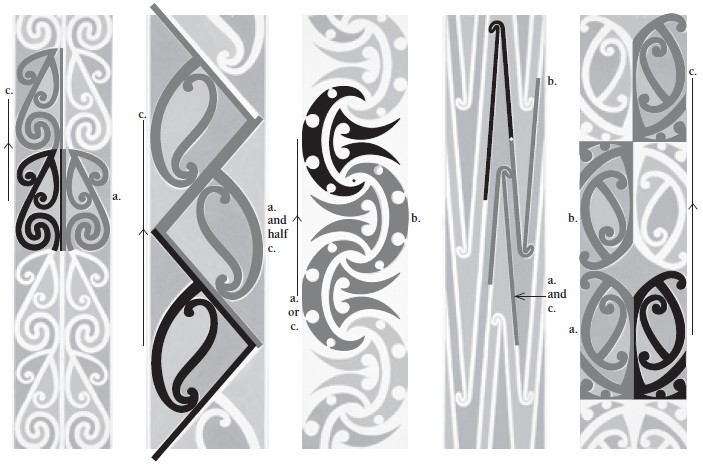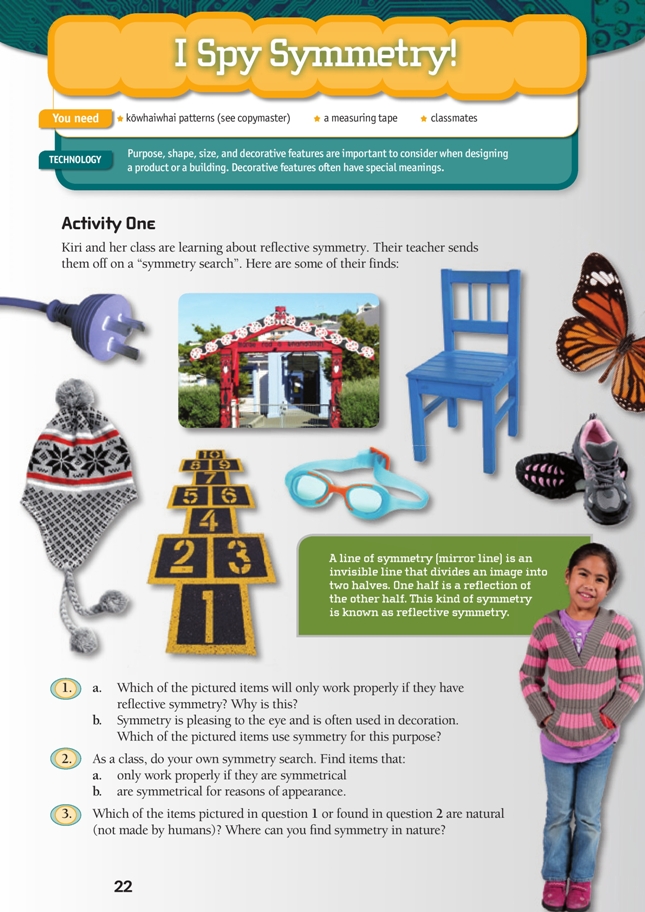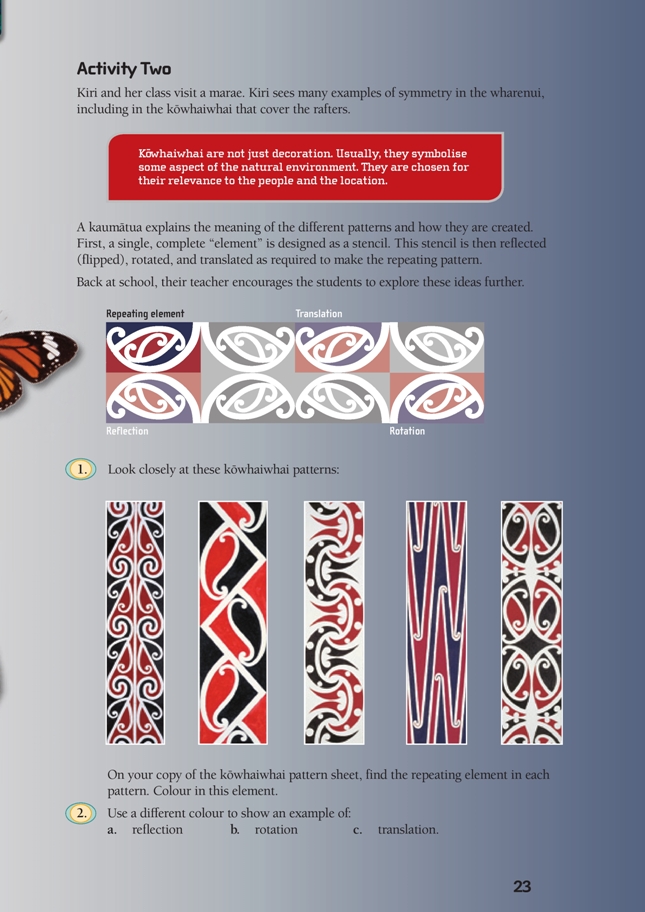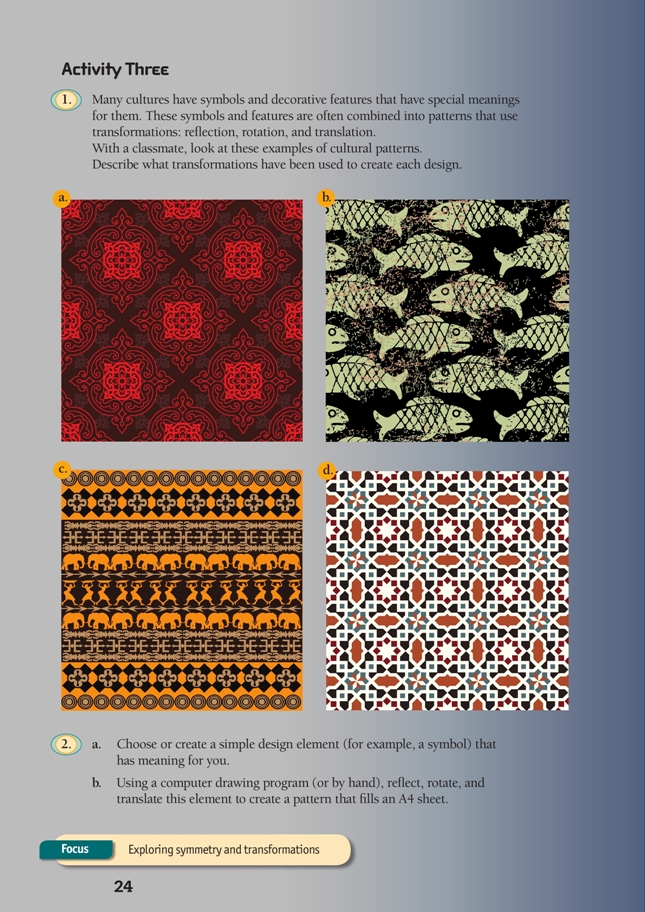This is a level 3 activity from the Figure It Out series.
A PDF of the student activity is included.
Click on the image to enlarge it. Click again to close. Download PDF (1738 KB)
Transformations and symmetry involve the manipulation of an element or group of elements by means of translation, reflection, or rotation. The human brain is constantly presented with new and often complex information. As a result, our minds look for patterns that can help us make sense of this information. People find visual patterns appealing. This may explain why transformations such as reflection, rotation, and translation are found in decorative motifs throughout the world. Exploring transformations and symmetry presents students with ways of interpreting and reflecting on their physical environment.
a measuring tape
kowhaiwhai patterns (see copymaster)
FIO, Creative Technology, Levels 2+-3+, I Spy Symmetry!, pages 22 - 24
In these activities, students explore symmetry and transformations in cultural patterns. Note that, when we think of symmetry, we tend to think of reflective (mirror line) symmetry. In fact, symmetry can also be rotational or translational. Rotational symmetry is the result of turning about a point (centre), even if it is not obvious where this point is. Translation is the result of movement in a straight line. Many designs that use symmetry involve combinations of two or more of these different transformations.
Activity One
Discuss reflective symmetry and how symmetry creates balance. Ask the students to imagine sitting on a chair with legs that are asymmetrical. Encourage them to identify objects in the classroom or the school grounds with at least one line of symmetry.
We tend to find designs that are symmetrical visually appealing. This could be because the symmetry creates a sense of strength and harmony.
Discuss whether symmetry is only found in man-made objects and challenge students to find examples of symmetry that are not man-made. Can they find non-living examples of symmetry? Even archetypal volcanoes like Taranaki, Ngāuruhoe, Rangitoto, or Fuji are only more-or-less symmetrical when viewed from some angles.
Ask the students to find examples of famous buildings that do not have obvious symmetry, for example, the Sydney Opera House. In the absence of symmetry, how has the architect achieved a pleasing design?
Activity Two
Have the students find and describe transformations in the cultural patterns. To describe reflection, they should try to identify the line of reflection (mirror line); to describe translation, the direction and distance of the movement; to describe rotation, the centre and amount of turn (most often, a half-turn).
See South Pacific Journey on nzmaths for a related Figure It Out, Level 3 geometry activity.
A useful starting place is to use the digital learning objects at www.nzmaths.co.nz. Geometry, Level 3 has an excellent activity titled Pasifika Patterns. Another good introductory activity is Pattern Pieces in Geometry, Figure It Out, Level 3.
Many classrooms and schools have a number of kowhaiwhai patterns evident in art or student text materials. Find examples of rotation, reflection, and transformations in the artwork that the students are already familiar with. Parents may be able to provide examples of cultural items that use transformations, for example, tapa cloth, tivaevae.
Activity Three
This activity provides an opportunity for students to represent their own culture and values in a meaningful way. Asymmetrical patterns can make designs using transformations more visually interesting.
Computers can be used to produce effective results with relative ease. Designs created using “paint” programmes are easily copied and transformations can be made electronically. These designs could be displayed around the classroom doorway.
Exploring the cultural significance of designs provides an opportunity for students to develop the key competency relating to others. Using the language of geometry to identify and describe transformations helps them to develop the key competency using language, symbols, and texts.
Technology-related student activities
- Examine local structures and find out whether their shapes or designs have particular meanings.
- Repeat the above for well-known international structures, such as the London Eye or the Eiffel Tower.
- Investigate cultural patterns that are relevant to the students in your class. Invite someone from the community to discuss with the students the significance of these patterns.
- Investigate logos and discuss their function.
- Create a design for a school or community structure. See www.techlink.org.nz/Case-studies/Classroom-practice/Materials/CP902-Marae-Panels/index.htm
Exploring the technology-related context
Product design often follows the concept of “form follows function”: there is no point having a wacky chair that isn’t balanced. The same applies to a pair of glasses or a building. In the design of many items and structures, balance is a primary consideration. Symmetry provides balance and strength because weight is evenly distributed.
Functional products, such as buildings, bridges, and gates can also reflect a community or a culture in their design. Shape, decorative elements, and colour can make a powerful symbolic statement.
Answers
Activity One
1. a. The school entranceway is symmetrical primarily because this makes it pleasing to the eye. The chair needs symmetry to ensure it sits squarely and distributes weight evenly. Symmetry is important for the goggles to fi t your face and seal around your eyes to keep water out. Shoes (as a pair) are symmetrical so that they give support and balance to your feet as you move. The butterfly needs symmetrical wings to balance its flight. Symmetry helps an electric plug fit easily into the socket, but electricity would still fl ow through a plug if each pin was a different shape. You could argue that a symmetrical hopscotch grid is necessary so that you can balance as you play, but you could still jump on an asymmetrical one.
b. The decoration on the entranceway, the hat design, and the coloured soles of the shoes use symmetry for appearance.
2. Practical activity. Answers will vary.
3. Answers will vary. Humans and other animals (including birds and fish) are symmetrical in their body shape and number and placement of legs and arms. But no one has a perfectly symmetrical face or body. Leaves have a certain symmetry, but only perfectly formed ones have full reflective symmetry. Insects such as the butterfly have reflective symmetry to balance their movements in flight. Shellfish may be symmetrical (especially bivalves, which have two joined halves), but many grow in spiral shapes, so are not symmetrical. It is very unusual to find symmetry in landforms. Volcanoes (such as Rangitoto, Ngāuruhoe, Taranaki, and Fuji) often appear symmetrical when seen from some angles but not others.
Activity Two
The repeating element of each pattern is shown in black. The other transformations are labelled a. reflection, b. rotation, and c. translation. The third and fourth patterns have a dot to mark the point of rotation.
Activity Three
1. The table below shows the types of transformations found in each pattern. In some of the patterns, you will find more than one example of a particular type of transformation.
| Reflection | Rotation | Translation | |
| a. | | | |
| b. | | | |
| c. | | | |
| d. | | | |
Note: pattern b involves reflection (to reverse direction) and translation.
2. a.–b. Practical activity


